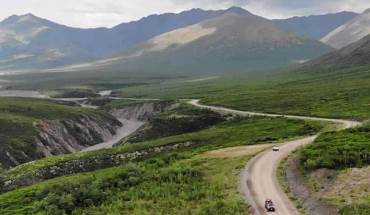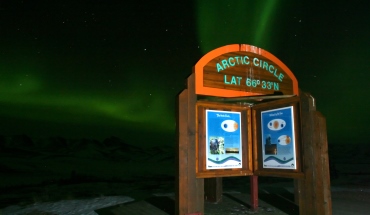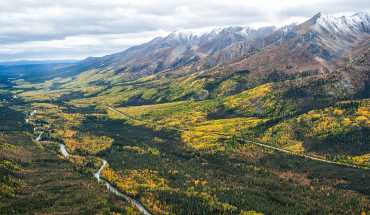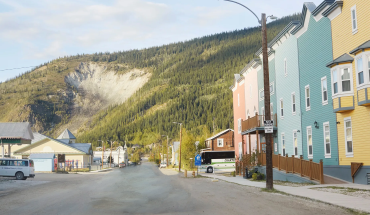Small Groups
Greater access to your expert local guide for a more intimate and personalised experience.
The Arctic Circle Drive & Hike tour goes into and beyond the Tombstone Range. We cross the continental divide between the Pacific Ocean and the Arctic Ocean in the Ogilvie Mountains and continue beyond to the Arctic Circle on the famed Dempster Highway. Stopping for day hikes along the way into the open terrain, we encounter sweeping, panoramic views of the incredible North. Optional Tombstone/Ogilvie Mountains Heli Tour available.
Greater access to your expert local guide for a more intimate and personalised experience.
Thousands of delighted guests with many returning for more. Experience the Sea to Sky difference and find out why.
Enthusiastic and knowledgeable, our guides offer invaluable source of information on local culture, history and sights making your trip one of a kind.
We know the range of dates we are requesting from Parks, but won't have confirmation of any dates until December, 2023.
Book Now
Day 0 – You arrive in Dawson City – (transport to Dawson City not included in this tour)
Accommodation Type: Hotel
All meals on this day are your responsibility.
We will pick you up from the airport and take you to your accommodation (included in tour price). The group will meet for introductions and trip briefing.
DAWSON CITY
SEA to SKY will pick up for all expeditions that originate in Dawson City. Should any problems or miscommunication arise, please email our office and we will forward you the guide team's contact info. (cell number and email address).
GETTING TO DAWSON CITY
Air Canada has daily flights to Whitehorse. Air North has scheduled flights from Calgary, Edmonton, Victoria and Vancouver to Whitehorse, and daily flights on to Dawson City. Please check with your travel agent or the Air North site for details.
Dawson City
We take care of your stay in Dawson City during this tour. If you are planning on arriving early or staying on later in Dawson, the following accommodations are recommended:
The Bunk House
The Downtown-A Coast Hotel
The Aurora Inn
This is a rugged hike for some portions. The best boots for this kind of backpacking are solid-able to take rough talus slopes, water proof, and with a full, stiff shank for ankle support. If you get new boots, it is important to break them in before your trip to ensure that they are comfortable and to minimize the risk of blisters. It is also a good idea to bring a pair of comfortable sandals or water shoes for wearing around camp and for crossing streams or other bodies of water.
For a six-day backpacking trip in varied terrain, you will want a backpack with a capacity of at least 65-85 liters, depending on the size of your gear and the type of trip you are taking.
Some key features to look for in a backpack for this type of trip include:
Comfort: Look for a backpack with a comfortable and well-padded hip belt and shoulder straps, as well as a good ventilation system to prevent your back from getting too hot and sweaty.
Durability: Choose a backpack made from strong and durable materials, such as ripstop nylon, to withstand the rigors of the trail.
Weather resistance: Consider a backpack with a waterproof or water-resistant cover or built-in rain cover to protect your gear from the elements.
Load-carrying ability: Look for a backpack with a sturdy frame and good load-carrying capacity to support the weight of your gear.
Organization: Choose a backpack with plenty of pockets, compartments, and attachment points to help you keep your gear organized and easily accessible.
Size: Make sure the backpack fits you well and is the right size for your body and your gear.
It is also a good idea to try on a few different backpacks and load them with weight to get a feel for how they carry before making your final decision.
Hiking poles can be a helpful tool for a rugged backpacking trip, as they can provide additional support and stability on rough or uneven terrain. They can also help to reduce the impact on your joints and muscles by distributing some of the load to your upper body.
However, whether or not to use hiking poles is ultimately a personal decision, and it may depend on factors such as your physical abilities, the terrain you will be hiking on, and your personal preference. Some people find that hiking poles help them to maintain balance and reduce fatigue, while others prefer to hike without them.
If you do decide to use hiking poles, it is important to choose a pair that is comfortable, lightweight, and adjustable to your height. It is also a good idea to practice using them before your trip to get a feel for how they work and to ensure that you are using them correctly.
Tips, or gratuities, are not mandatory. However, please consider what service is actually being given to you. While you might think that the company should just pay the guides better, it is not so simple. We do work in a competitive market, and pay rates are a function of the trip prices. If we could double prices, we would pay guides significantly better. At Sea to Sky, we have some of the better pay rates in the industry, and we are always pushing our competitors to increase pay rates for guides, but there is only so much we can do. Guides are seasonal workers. They shift off of their summer season to winter activities, or fill in with retail work, which is usually little more than minimum wage, often to periods of no work between seasonal jobs. It is a hard job, and wearing on the body.
The guides carry most of the group gear, so they have heavier loads than you have, all for you, because they would not be carrying much of the extras on a personal trip. Your guides are teaching you, helping you through challenges, cooking for you and serving you your meals, providing a safety envelope for you, and if you have a really good guide, they are filling you up with a deeper experience of being in the place you are visiting by telling you about the flora, fauna and history of the place.
So, how much should you tip your guides?
If you ate every meal out in a day, at a good, but low-cost restaurant, you would probably tip between $10 and $15 per day. If you were travelling and visiting a city and ate all your meals out, this is about how much you would tip for the day, low end. I would submit that the guides are feeding you all three meals in a day, AND serving you in so many more ways. That makes $10-$15 a day a minimum consideration, really. 10% to 15% of a trip price has been another rule of thumb that has been used. If your trip price is $2000, then $200 to $300 split between the guides is reasonable, and falls within that standard. Like most humans, guides are motivated when they are recognized and valued.
Your circumstances matter. If you are a student and clearly struggled to put together the cost of the trip, or have other circumstances that limit your ability to tip, guides understand and honour your appreciation, no matter what the size. However, if you have a large income or high net worth and means, a small tip might be a slap in the face. If you have means and you clearly and vocally appreciated the guides and all they did, and then leave a $50 tip after a 7 to 9 day trip, that amount would probably be insulting. If you have a fairly large income or net worth, you likely spend it on higher end restaurants, and maybe higher cost wine, drinks or desserts. You might even give a $50 tip for a dinner meal out-for ONE meal, so just consider your ability to tip and the level of service you received over the whole trip.
The largest tip any of our guides has received from one person is $1,500.00 for a 9-day trip. This was highly unusual, and was because we went way out of the way to replace her boots in the middle of the trail because her boots were falling apart, and this was on top of paying for the boots and their transport out to the trail. That was extraordinary service, and an extraordinary tip. On average, guides usually receive about $75 to $125 from each guest for each guide.
At Sea to Sky, we also split the tips between the lead and assistant guides, and proportionally with any drivers. We have a strong culture of teamwork and both the lead and assistant guides play essential roles for you, so we ensure both share equally in the tips for the trip. Tips are not shared or taken by owners and managers not on your trip, unless you send it separately and specify it is for service before or after a trip.




For any wilderness adventure, "layering" is one of the most critical concepts.
Layering clothing can have several advantages:
Temperature regulation: Layering allows you to adjust your level of warmth by adding or removing layers as needed. This can be especially useful in unpredictable weather or in environments with fluctuating temperatures.
Comfort: Layering can help you stay comfortable in a range of temperatures and activities. For example, if you're going for a hike, you can wear a base layer to wick sweat away from your skin, a mid layer for insulation, and a outer layer to protect against wind and rain.
Versatility: Layering allows you to mix and match different pieces of clothing to create different looks and adapt to different situations.
Style: Layering can add depth and interest to your outfit, allowing you to express your personal style and create a polished look.
Protection: Layering can also provide protection against the elements, such as wind, rain, and cold temperatures.